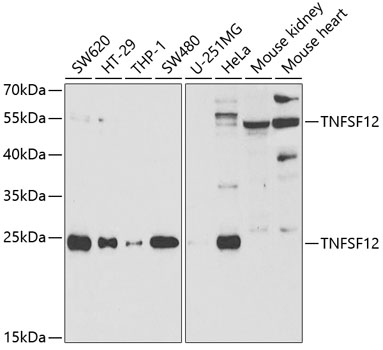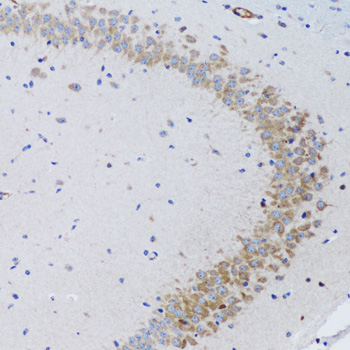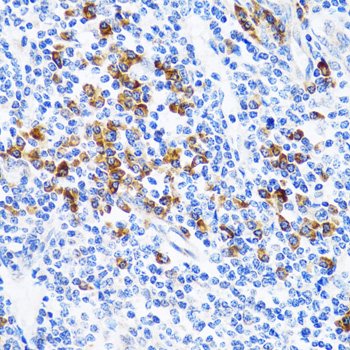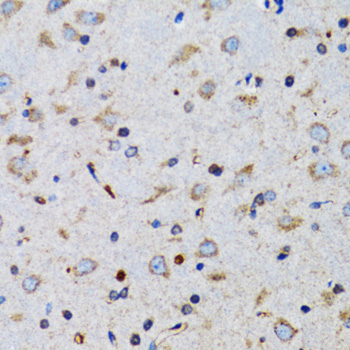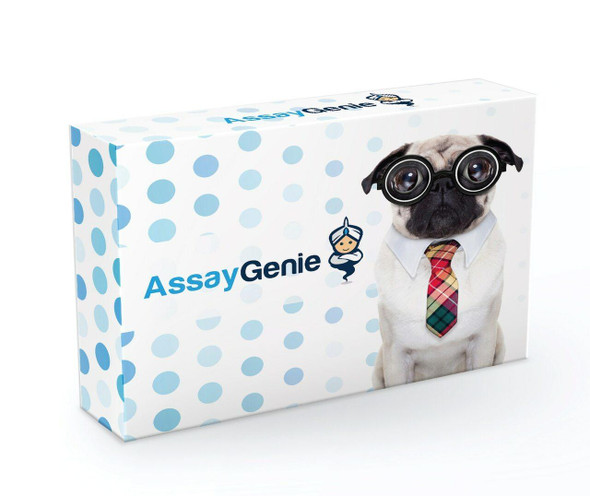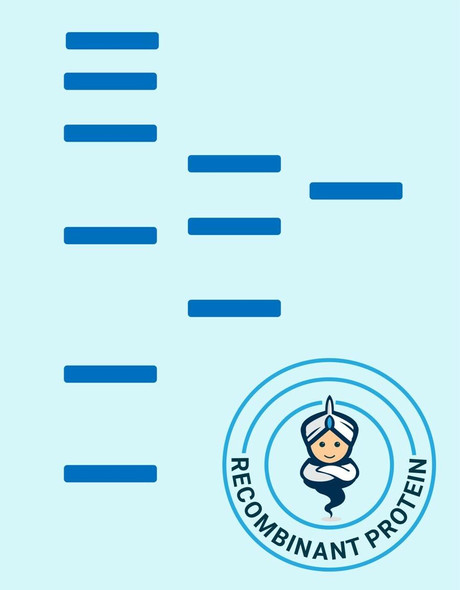Cardiovascular Antibodies
Anti-TNFSF12 Antibody (CAB5659)
- SKU:
- CAB5659
- Product Type:
- Antibody
- Reactivity:
- Human
- Reactivity:
- Mouse
- Reactivity:
- Rat
- Host Species:
- Rabbit
- Isotype:
- IgG
- Antibody Type:
- Polyclonal Antibody
- Research Area:
- Cardiovascular
Description
| Antibody Name: | Anti-TNFSF12 Antibody |
| Antibody SKU: | CAB5659 |
| Antibody Size: | 20uL, 50uL, 100uL |
| Application: | WB IHC IF |
| Reactivity: | Human, Mouse, Rat |
| Host Species: | Rabbit |
| Immunogen: | Recombinant fusion protein containing a sequence corresponding to amino acids 42-123 of human TNFSF12 (NP_003800.1). |
| Application: | WB IHC IF |
| Recommended Dilution: | WB 1:500 - 1:2000 IHC 1:50 - 1:200 IF 1:50 - 1:200 |
| Reactivity: | Human, Mouse, Rat |
| Positive Samples: | SW620, HT-29, THP-1, SW480, U-251MG, HeLa, Mouse kidney, Mouse heart |
| Immunogen: | Recombinant fusion protein containing a sequence corresponding to amino acids 42-123 of human TNFSF12 (NP_003800.1). |
| Purification Method: | Affinity purification |
| Storage Buffer: | Store at -20'C. Avoid freeze / thaw cycles. Buffer: PBS with 0.02% sodium azide, 50% glycerol, pH7.3. |
| Isotype: | IgG |
| Sequence: | VSLG SRAS LSAQ EPAQ EELV AEED QDPS ELNP QTEE SQDP APFL NRLV RPRR SAPK GRKT RARR AIAA HYEV HPRP GQDG AQ |
| Gene ID: | 8742 |
| Uniprot: | O43508 |
| Cellular Location: | Cell membrane, Secreted, Single-pass membrane protein, Single-pass type II membrane protein |
| Calculated MW: | 27kDa/36kDa |
| Observed MW: | 25kDa/55kDa |
| Synonyms: | TNFSF12, APO3L, DR3LG, TNLG4A, TWEAK |
| Background: | The protein encoded by this gene is a cytokine that belongs to the tumor necrosis factor (TNF) ligand family. This protein is a ligand for the FN14/TWEAKR receptor. This cytokine has overlapping signaling functions with TNF, but displays a much wider tissue distribution. This cytokine, which exists in both membrane-bound and secreted forms, can induce apoptosis via multiple pathways of cell death in a cell type-specific manner. This cytokine is also found to promote proliferation and migration of endothelial cells, and thus acts as a regulator of angiogenesis. Alternative splicing results in multiple transcript variants. Some transcripts skip the last exon of this gene and continue into the second exon of the neighboring TNFSF13 gene; such read-through transcripts are contained in GeneID 407977, TNFSF12-TNFSF13. |
| UniProt Protein Function: | TNFSF12: Binds to FN14 and possibly also to TNRFSF12/APO3. Weak inducer of apoptosis in some cell types. Mediates NF-kappa-B activation. Promotes angiogenesis and the proliferation of endothelial cells. Also involved in induction of inflammatory cytokines. Homotrimer (Potential). Interacts with the angiogenic factor AGGF1/VG5Q. Highly expressed in adult heart, pancreas, skeletal muscle, brain, colon, small intestine, lung, ovary, prostate, spleen, lymph node, appendix and peripheral blood lymphocytes. Low expression in kidney, testis, liver, placenta, thymus and bone marrow. Also detected in fetal kidney, liver, lung and brain. Belongs to the tumor necrosis factor family. |
| UniProt Protein Details: | Protein type:Apoptosis; Membrane protein, integral; Motility/polarity/chemotaxis; Cytokine Chromosomal Location of Human Ortholog: 17p13 Cellular Component: extracellular space; perinuclear region of cytoplasm; integral to plasma membrane Molecular Function:protein binding; cytokine activity; tumor necrosis factor receptor binding; receptor binding Biological Process: positive regulation of angiogenesis; apoptosis; positive regulation of protein catabolic process; endothelial cell migration; immune response; positive regulation of endothelial cell proliferation; angiogenesis; cell differentiation; signal transduction |
| NCBI Summary: | This gene encodes a member of the tumor necrosis factor superfamily. It encodes a hybrid protein composed of the cytoplasmic and transmembrane domains of family member 12 fused to the C-terminal domain of family member 13. The hybrid protein is membrane anchored and presents the receptor-binding domain of family member 13 at the cell surface. It stimulates cycling in T- and B-lymphoma cell lines. [provided by RefSeq, Jul 2008] |
| UniProt Code: | O43508 |
| NCBI GenInfo Identifier: | 21362987 |
| NCBI Gene ID: | 407977 |
| NCBI Accession: | O43508.1 |
| UniProt Secondary Accession: | O43508,Q8IZK7, Q8WUZ7, |
| Molecular Weight: | 36,589 Da |
| NCBI Full Name: | Tumor necrosis factor ligand superfamily member 12 |
| NCBI Synonym Full Names: | TNFSF12-TNFSF13 readthrough |
| NCBI Official Symbol: | TNFSF12-TNFSF13 |
| NCBI Official Synonym Symbols: | TWE-PRIL |
| NCBI Protein Information: | TNFSF12-TNFSF13 protein; tumor necrosis factor (ligand) superfamily, member 12-member 13 |
| UniProt Protein Name: | Tumor necrosis factor ligand superfamily member 12 |
| UniProt Synonym Protein Names: | APO3 ligand; TNF-related weak inducer of apoptosis; TWEAK |
| UniProt Gene Name: | TNFSF12 |
| UniProt Entry Name: | TNF12_HUMAN |
View AllClose


